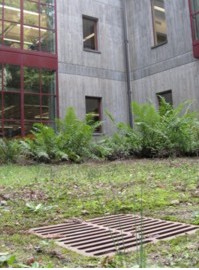Drain Inlets Around Campus
To protect the built environment from flooding and structural damage storm water must be conveyed away from the built environment. Varied infrastructure is used to collect, transport and disperse storm water.
S&E Library Communications Building Science & Engineering Library

Downspouts collect and drain water from rooftops. They may be connected to a drain inlet at ground level or if environmental conditions allow they may flow to a swale, the landscape or other surfaces.
Science & Engineering Library Science & Engineering Library
Thimann Lecture Hall Earth & Marine Sciences
Exterior paved surfaces and landscaping near buildings may be punctuated by several types of storm drain inlets and/or catch basins. See photos above and on the left.
Catch basins in roads and some other surfaces may have design features that capture pollutants. Catch basins equipped with an outflow pipe elevated (typically 12 inches) above the bottom of the basin allows for settling of heavier materials such as dirt.
Earth & Marine Sciences
While an outflow pipe equipped with a down turned elbow draws water from below the water surface and allows for suspended materials such as oils, Styrofoam and other floating litter to be retained. In roadways and other areas subject to vehicle traffic, oil absorbent socks are used to capture petroleum products that would otherwise be washed into the environment. All of these design features require periodic inspections and maintenance in order to maintain system effectiveness. Thimann Storm drain inlets and access points (cleanouts) may be marked "Storm". Return to Science Hill Map
